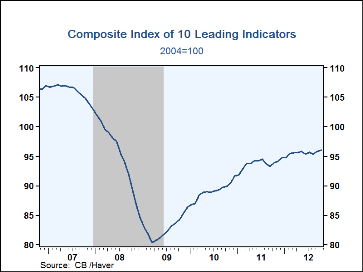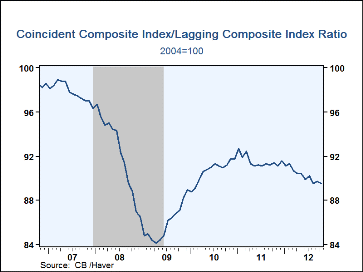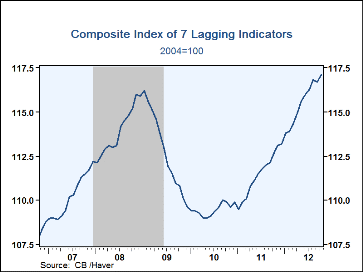 Global| Nov 21 2012
Global| Nov 21 2012U.S. Leading Indicators Improve Further
by:Tom Moeller
|in:Economy in Brief
Summary
The Leading Economic Indicator index from the Conference Board increased 0.2% during October following a 0.5% September gain, initially estimated at 0.6%. Fifty percent of the component series had a positive influence on the index [...]
The Leading Economic Indicator index from the Conference Board increased 0.2% during October following a 0.5% September gain, initially estimated at 0.6%. Fifty percent of the component series had a positive influence on the index last month. A steeper interest rate yield curve, the leading credit index and lower initial claims for unemployment insurance had the largest positive influences. These increases were offset by fewer building permits, lower consumer expectations for business & economic conditions and a lower ISM new orders index.
The index of coincident indicators ticked up 0.1% after a 0.2% September rise. Three of the four component series had a positive influence on the total, notably manufacturing and trade sales. The index of lagging indicators rose 0.3% during October following a revised 0.1% September decline. Two-thirds of the component series rose, notably commercial & industrial loans outstanding. The change in labor costs per unit of output fell along with the average duration of unemployment.
Another leading economic series is the ratio of coincident-to-lagging indicators. It measures how the economy is performing versus its excesses. The figure fell slightly last month and remained sharply below its high during January last year.
The Conference Board figures are available in Haver's BCI database; the components are available there, and most are also in USECON. The forecast figure for the Consensus are in the AS1REPNA database. Visit the Conference Board's site for coverage of leading indicator series from around the world.
The Role of Monetary Policy in Bolstering Economic Growth is last week's speech by John C. Williams, President and CEO, Federal Reserve Bank of San Francisco and it can be found here.
| Business Cycle Indicators (%) | Oct | Sep | Aug | Y/Y | 2011 | 2010 | 2009 |
|---|---|---|---|---|---|---|---|
| Leading | 0.2 | 0.5 | -0.4 | 2.3 | 5.2 | 7.6 | -12.8 |
| Coincident | 0.1 | 0.2 | -0.4 | 1.7 | 2.8 | 2.5 | -7.7 |
| Lagging | 0.3 | -0.1 | 0.4 | 3.9 | 1.8 | -2.9 | -1.0 |
Tom Moeller
AuthorMore in Author Profile »Prior to joining Haver Analytics in 2000, Mr. Moeller worked as the Economist at Chancellor Capital Management from 1985 to 1999. There, he developed comprehensive economic forecasts and interpreted economic data for equity and fixed income portfolio managers. Also at Chancellor, Mr. Moeller worked as an equity analyst and was responsible for researching and rating companies in the economically sensitive automobile and housing industries for investment in Chancellor’s equity portfolio. Prior to joining Chancellor, Mr. Moeller was an Economist at Citibank from 1979 to 1984. He also analyzed pricing behavior in the metals industry for the Council on Wage and Price Stability in Washington, D.C. In 1999, Mr. Moeller received the award for most accurate forecast from the Forecasters' Club of New York. From 1990 to 1992 he was President of the New York Association for Business Economists. Mr. Moeller earned an M.B.A. in Finance from Fordham University, where he graduated in 1987. He holds a Bachelor of Arts in Economics from George Washington University.










